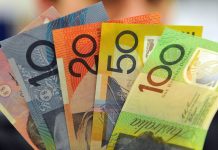The Aussie rallied steadily after the Reserve Bank of Australia left its target overnight cash rate unchanged at a record-low 0.75% as expected. As a reminder, the monetary authorities delivered 25-basis point rate cuts in June, July and October.
The RBA said expects a gradual pickup in inflation and GDP growth, and therefore the monetary authorities have signaled a pause in its easing cycle for now. At the same time, RBA Governor Philip Lowe admitted that the risks are tilted to the downside, despite a reasonable outlook for the world economy.
In a knee-jerk reaction, the Australian currency was nearly unchanged but jumped quickly later and registered daily highs around 0.6925 after a sell-off on Monday. It looks like traders have realized that it’s now the right moment to price out additional cuts in the medium term as the regulator needs time to assess the effect from recent easing. Now, expectations of a cut by the end of this year stand around 25%.

On Monday, AUDUSD suffered decent losses on a combination of weak domestic data and a widespread demand for the greenback. Australian retail sales rose 0.2%, less than half the rate markets had expected, with the rate of growth was the lowest since 1990s in annual terms. In fact, the report showed that consumer spending show little response to the policy measures, taken by the RBA since summer. So, it may take some more time to see the effect from the central bank’s steps.
In the short-term, the pair could extend gains, or at least stay elevated should risky assets continue to gain amid the ongoing Us-China trade optimism. In latest developments on this front, both countries are considering rolling back some tariffs in order to strike a partial trade deal. Now, investors are eager to see further progress on the so-called “phase one” pact.
Technically, AUDUSD needs to hold above 0.6914 in order to challenge late-July highs around 0.6929, registered last week amid a broad USD weakness in the aftermath of the FOMC policy decision. On the downside, an important support zone comes at 0.6880. In the short-term, the pair could be affected by the upcoming US service PMIs. Strong data may cause a partial profit taking after a local rally.





























